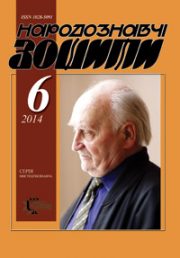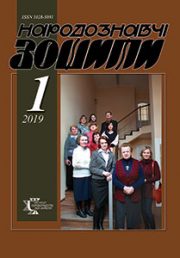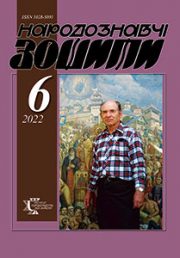The Ethnology Notebooks. 2021. № 5 (161), 1063—1077
UDK 94:[398.341:643.01](477.85)”18/19″
DOI https://doi.org/10.15407/nz2021.05.1063
BOYKO Ihor
- ORCID ID: https://orcid.org/0000-0002-3828-1835
- Doctor of Philosophy, Researcher
- of the Institute of Ethnology of the National Academy of Sciences of Ukraine,
- in the Department of Social Antropology,
- Svobody Avenue 15, 79000, Lviv, Ukraine
- Contacts: e-mail: I.Boyko@nas.gov.ua
LACH Janusz
- ORCID ID: http://orcid.org/0000-0001-8451-5957
- Doctor of Philosophy, lecturer University of Wroclaw,
- Faculty of Earth Science and Environmental Management
- Department of Regional Geography and Tourism
- street Z. Cybulskiego 32, room 152, 50-205 Wroclaw
- Contacts: e-mail: janusz.lach@uwr.edu.pl
Abstract. Introduction: The authors aim to find out the peculiarities of traditional construction on the glades of the first half of the XX century in Boykivshchyna, based on their own field materials; to reveal the local specifics, the cultural phenomena origin. The research object is the traditional glades construction in Boykivshchyna; the subject: planning, building material, heating system, etc. The methodological basis of the article is cultural-ecological, comparative and cross-cultural analysis. The study area includes Skoliv district of Lviv region, Mizhhirya district of Zakarpattia region and Rozhnyativ district of Ivano-Frankivsk region.
As the material showed, the glades construction was a kind of «laboratory» where various types of planning and construction equipment were born, tested, and preserved. A cross-cultural analysis of the glades yards planning has indicated that most of the types of planning in Boykivshchyna, as well as in the Carpathians as a whole, have glades origin. A planning option: «hata» + «boyishche» + «staynja» probably has glade origin, which is typical for the rural architecture of the Western Boykivshchyna, where glades are almost not preserved. Thus, the authors suggest that glades in the past were widespread in Boykivshchyna almost everywhere.
Glade construction of the Carpathians has many common features, which is caused as with the functional load, the impact of construction on dairy farms, so the location of glades in the mountain-forest belt usually above the farmsteads. At the same time, the affiliation of the glades to certain natural and cultural regions also makes it possible to single out their specialty. The authors consider specific phenomena of Boykivshchyna glade construction: the rare spread of free buildings; the spread of different variants of closed buildings, among which the variant of a house (apartment block) + a stable with a door in a narrow wall, prevails. This type of yard is also characteristic of the Transylvanian-Maramures region, which probably indicates the genesis of this type in Boykivshchyna. The most diverse region, in terms of planning, application of building materials and roofing techniques, heating systems, etc., obviously should be considered Oporo-Oryavsky area.
Keywords: Boykivshchyna, glades construction, planning, hut (khyzhka), kolyba, osenivka, wintering grounds.
Received 4.06.2021
REFERENCES
- Bojko, I. (2016). Stockbreeding And Seasonal Construction. In The Carpathians (Late XIX — The First Half of XX Century): Attempt Of Classification. The Ethnology Notebooks, 6 (132), 1350—1361 [in Ukrainian].
- Bojko I., Lach J. Glade Farming as a Product and a Factor in the Formation of Landscape (Using the Example of the Boikivshchyna Region in the Ukrainian Carpathians). Dissertations Of Cultural Landscape Commission. 2020. № 43 (1). S. 73—96.
- Rayinfus, R. (2020). Materials for studying the material culture of Boyko people. Lviv [in Ukrainian].
- Radovych, R. (2015). Sambir Folk Architecture XIX — Early XX Century (Residential and economic complex). Kyiv [in Ukrainian].
- Tyvodar, M. (1994) Traditional cattle breeding in the Ukrainian Carpathians of the second half of the XIX — first half of the XX century. Uzhhorod [in Ukrainian].
- Kubijowycz, W. (1920—1921). A contribution to the Gorgan’s anthropogeography. Polish Geographical Review (Vol. II, pp. 146—149). Warsawa [in Polish].
- Kubijowycz, W. (1926). Shepherd life in the Eastern Beskids. Krakow [in Polish].
- Kral, I. (1932—1936). Borzava in Subcarpathian Rus (Vol. I—III). Praha [in Czech].
- Kulytsky, M. (1934). Winter houses in the Southern Carpathians. Life and knowledge, 2, 58—59. Lviv [in Ukrainian].
- Langer, J. (1973). Trstena 600 years old. Martin [in Slovak].
- Lach, J., Musial, M. (2015). Presence and designation of tradition for the common cultural heritage of the Beskid Mountains Small: entry in landscape. Wroclaw [in Polish].
- Boyko, I. (2015). Summer cowsheds in the western and central (Ukrainian) Carpathian Mountains: ethnoecological parallels among the Ukrainian, Slovak, Polish, and Czech cultures. Lemkowie, Bojkowie, Rusini — history, society, material and spiritual culture (Vol. V, pp. 361—376). Slupsk; Zielona Gora; Svidnik [in Ukrainian].
- Boyko, I. (2007—2011). Field ethnographic materials on the theme «Material culture of Boykivshchyna», collected in Starosambir, Turka, Skole districts of Lviv region, Volovets, Velyko-Berezny, Irshava, Svalyava, Mizhhiria districts of Zakarpatska region, Rozhnyativ, Bohorodchany districts of Ivano-Frankivsk. In Archive of the NASU. F. 1. Оp. 2. Od. save 610 [in Ukrainian].
- Langer, J. (1981). Construction form of seasonal and permanent settlements in the Carpathians in terms of historical and social. Slovak Ethnology, 28, 51—62 [in Slovak].
- Boyko, I. (1998—2005). Field ethnographic materials on the theme «System of material support of Boykos», collected in Turka, Skole districts of Lviv region, Volovets, Velyko-Berezny, Mizhhiria districts of Zakarpattia region, Rozhnyativ, Bohorodchany, Dolyna districts of Ivano-Frankivsk. In Archive of the IN NANU. F. 1. Оp. 2. Od. save 469 [in Ukrainian].
- Dubyna, R., Hlavacka, L. (2008). Expedition to the eastern Boykivshchyna. Folk Art and Ethnology, 5, 39—40 [in Ukrainian].
- Bednarik, R. (1963). To study cholvarks in Kysucie. Retrieved from: http://archeologickemuzeum.sk/en/Zbornik Slovenskeho narodneho muzea. Emografia (Vol. LVII, pp. 28—39) [in Slovak].
- Botik, J. (2014). Vysna Boca. Nizna Boca: patriotic monograph. Bratislava [in Slovak].
- Chlebana, M. (1972). Contribution to the study of summer cattle breeding in the area of Spisske Zamaguria. Retrieved from: http://archeologickemuzeum.sk/en/Zbornik Slovenskeho narodneho muzea. Emografia, 13, 173—197 [in Slovak].
- Kubijowycz, W. (1927). Shepherding life in the Magorskie Beskids. Krakow [in Polish].
- Langer, J. (1965). Folk architecture of the northern part of Orava. Collection of the Slovak National Museum, 59, 23—59 [in Slovak].
- Plessingerova, A., & Vareka, J. (1973). Summer constructions and their use in the area of Slovak Javorniky. Zbornik Slovenskeho narodneho muzea. Emografia, 14, 179—212 [in Czech].
- Podolak, J. (1960). Traditional ways of cattle wintering in Horehronie. Slovak Ethnology, 8, 268—322 [in Slovak].
- Sliwinski, W. (2015) Former glases construction in the Jaworzyna Krynicka range (a few words of comparison with the shacks in Gorce). Sacz-Spis Notebooks, 9, 113—122 [in Polish].






